
Hydrocolloid Innovations in Regional Delights: Perfecting New England Clam Chowder
SUBSCRIBE TO OUR BLOG
Promotions, new products, and recipes.
As a professional copywriting journalist, I am always on the lookout for innovations that can elevate traditional recipes. Today, I want to talk about hydrocolloids and how they can transform one of the most beloved regional dishes in the United States - New England clam chowder.
New England clam chowder is a soup that has been enjoyed for centuries, but with the help of hydrocolloids, chefs and food scientists are finding new ways to improve its texture, consistency, and flavor. In this article, I will delve into the science of hydrocolloids and explore their impact on New England clam chowder.
Key Takeaways:
- Hydrocolloids are a class of food additives that can improve the texture, consistency, and flavor of food products.
- New England clam chowder is a beloved regional dish with a rich history and traditional preparation methods.
- Hydrocolloids such as xanthan gum, agar agar, and carrageenan can act as thickening agents, emulsifiers, and stabilizers in clam chowder, enhancing its creaminess, flavor, and stability.
- Hydrocolloids offer endless opportunities for experimenting with different flavor variations while staying true to the essence of traditional recipes.
The Essence of New England Clam Chowder
As a New England native, I can attest that there is nothing quite like a warm bowl of clam chowder on a cold winter day. This regional dish has been a staple in the northeastern United States for centuries, and its popularity has only continued to grow.
At its most basic, New England clam chowder is a creamy soup made with tender clams, potatoes, onions, and sometimes bacon. The recipe varies slightly depending on the region, but the essence of the dish remains the same: a hearty, comforting soup that warms you up from the inside out.
The origins of New England clam chowder are somewhat murky, but most historians agree that it was likely created by French, British, or American settlers who were drawn to the abundance of clams in the region. Over time, the recipe evolved and became a beloved regional specialty.
Today, New England clam chowder is served in restaurants and homes throughout the United States, but its heart remains in the Northeast.
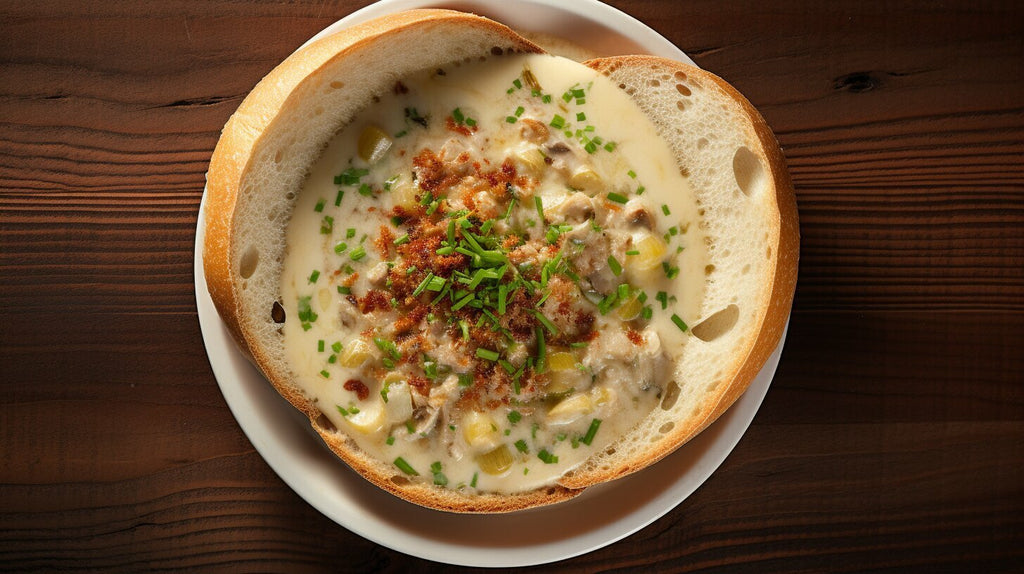
New England clam chowder using xanthan gum as a thickener.
"I must down to the seas again, to the lonely sea and the sky, and all I ask is a tall ship and a star to steer her by." - John Masefield
Introducing Hydrocolloids: A Game-changer in the Culinary World
As a professional copywriting journalist, I have witnessed firsthand the remarkable impact of hydrocolloids in the culinary industry. Hydrocolloids are a class of food additives that have become increasingly popular in recent years due to their versatility and effectiveness in improving the texture and consistency of various food products.
Hydrocolloids are commonly used as thickeners, emulsifiers, and stabilizers. They are derived from natural sources such as plants, algae, and animal products and offer a cost-effective and sustainable solution for culinary innovation.
Hydrocolloids have revolutionized the way chefs approach recipe development, allowing them to achieve textures and consistencies that were once impossible. They enable chefs to experiment with different flavors, maintain the integrity of the ingredients, and create new culinary experiences for their customers.
As a result, hydrocolloid innovations have become a game-changer in the culinary world, providing chefs with a tool to push the boundaries of traditional cuisine and create new culinary delights.

"Hydrocolloid innovations have become a game-changer in the culinary world, providing chefs with a tool to push the boundaries of traditional cuisine and create new culinary delights."
Hydrocolloid Magic: Transforming Clam Chowder
Now that we have introduced hydrocolloids and their role in enhancing food products, let's dive into how they transform one of the most beloved regional dishes in the United States: New England clam chowder.
Hydrocolloids such as carrageenan, xanthan gum, and agar agar are commonly used in clam chowder to enhance its texture and mouthfeel. Carrageenan, for example, is extracted from red seaweed and provides a smooth, creamy consistency to the soup. Xanthan gum, on the other hand, is a polysaccharide produced by fermenting sugars and helps thicken the soup without affecting its taste. Finally, agar, obtained from seaweed, provides a firm, gel-like texture that gives the soup a more robust mouthfeel.
By adding hydrocolloids to clam chowder, chefs can create a consistent, silky texture that enhances the overall taste experience. It allows for a better integration of flavors, ensuring that each spoonful contains a harmonious blend of ingredients that work together to create a delicious meal.
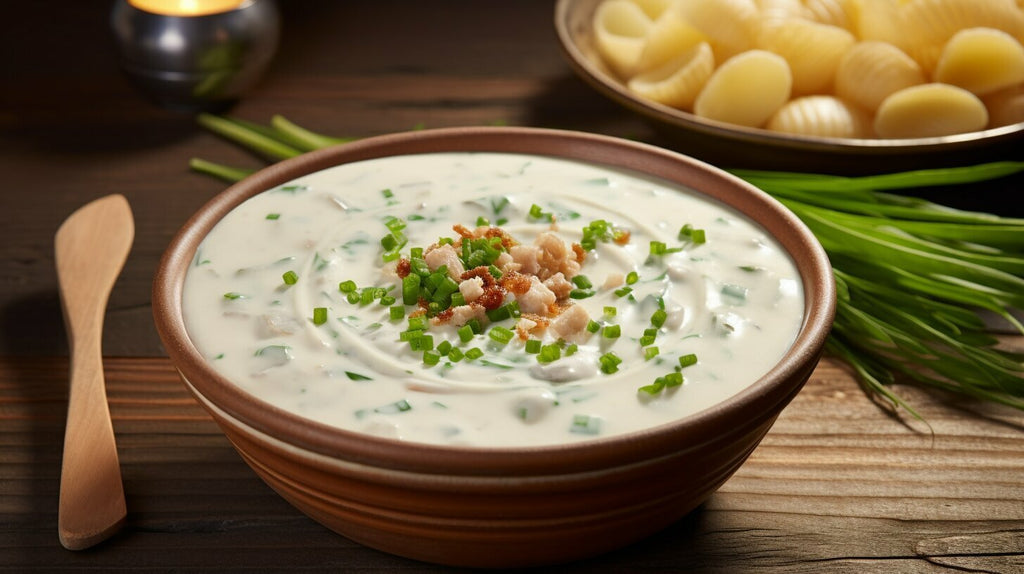
As shown in the image above, the addition of hydrocolloids to clam chowder such as agar agar can significantly affect the consistency and texture of the soup. Hydrocolloids help create a more stable product that maintains its texture even after multiple reheating and cooling cycles.
Using hydrocolloids in clam chowder also opens up a world of flavor innovations. By experimenting with different hydrocolloids, chefs can create entirely new variations of the soup while still preserving its traditional essence. Hydrocolloids, especially carrageenan which is made from seaweed, can be used to create vegan or vegetarian versions of clam chowder, providing a perfect solution for those with dietary restrictions.
In summary, hydrocolloids are an essential tool in perfecting New England clam chowder. They provide stability, creaminess, and integration of flavors while creating endless possibilities for innovation.
Achieving Creaminess: Hydrocolloid as a Thickening Agent
One of the most exciting properties of hydrocolloids is their ability to act as a thickening agent in New England clam chowder, resulting in a creamy, velvety texture. Unlike traditional thickeners such as flour or cornstarch, hydrocolloids add no flavor or taste of their own, making them perfect for preserving the authentic taste of this classic dish.
One commonly used hydrocolloid in clam chowder is xanthan gum, which can be added in small amounts to achieve the desired thickness and consistency. It's important to note that adding too much xanthan gum can result in a slimy or gummy texture, so it's best to start with small amounts and adjust accordingly.
The use of hydrocolloids also allows for customization to individual preferences. For example, some may prefer a thicker, more substantial chowder, while others may prefer a lighter, brothy consistency. Hydrocolloids make it easy to adjust the thickness and creaminess of the soup to suit different tastes.
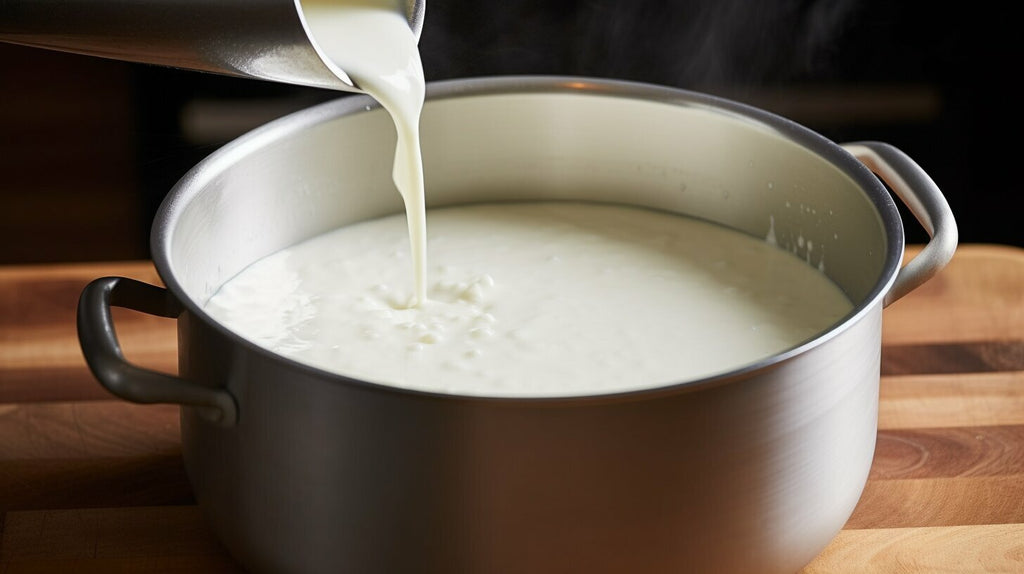
Adding xanthan gum and cream to thicken New England clam chowder.
Overall, hydrocolloids are an essential tool for achieving the perfect balance between flavor and texture in New England clam chowder. They offer an infinite range of options for creating a creamy, velvety consistency and represent a revolutionary innovation in the world of culinary arts.
Emulsifying for Flawless Integration
Hydrocolloids not only serve as thickening agents but also act as emulsifiers that enable the different ingredients to blend seamlessly, creating a harmonious flavor profile.
Emulsifying agents are essential in creating a stable emulsion, ensuring that the soup does not separate into different phases. Emulsifiers have a hydrophilic and a hydrophobic end, which can interact with both water and oil-based components, stabilizing the mixture.
In clam chowder, the emulsifying properties of hydrocolloids are particularly crucial in achieving a smooth and creamy texture without an oily film on the surface of the soup. By facilitating the even distribution of fat and other components in the soup, hydrocolloids enable the recipe to maintain its consistency and flavor, even when reheated.
Hydrocolloids also help to reduce the amount of fat needed in the recipe and allow for the use of alternative fats such as plant-based oils. This feature is particularly significant for those who wish to maintain a low-fat or vegetarian diet.
In conclusion, the emulsifying properties of hydrocolloids allow the ingredients in New England clam chowder to integrate perfectly, delivering a velvety texture and a consistent taste.
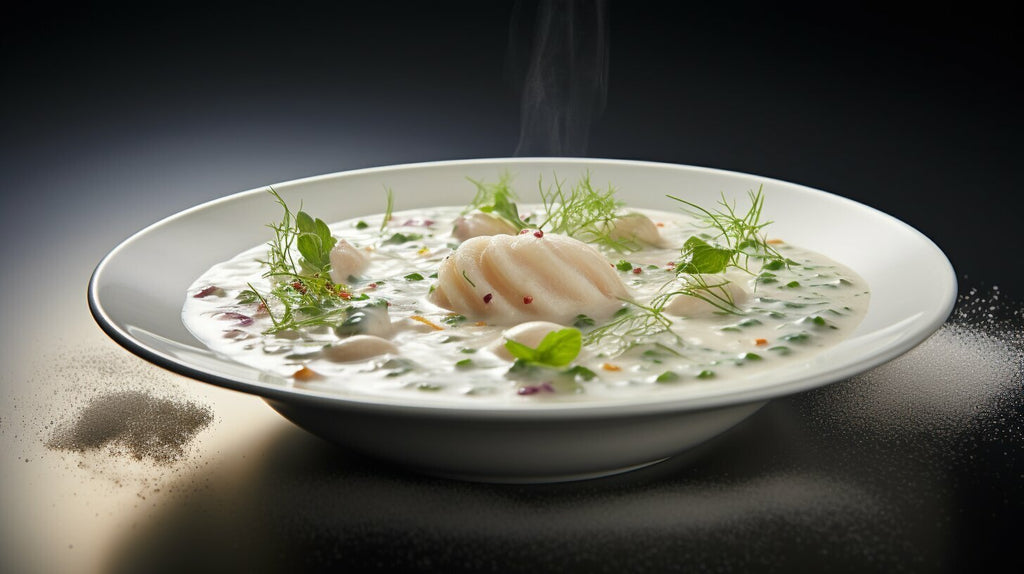
Stability through Hydrocolloids
When it comes to creating the perfect New England clam chowder, maintaining stability is crucial. Hydrocolloids play a significant role in achieving this stability by preventing ingredient separation and maintaining the soup's consistency, even under different storage and reheating conditions.
Hydrocolloids work by forming a network of molecules that entrap water, creating a stable environment that prevents ingredients from settling or separating. This network also helps to maintain the soup's texture and consistency by preventing it from becoming too thick or thin.
Common hydrocolloids used in clam chowder include carrageenan, xanthan gum, and agar, each with unique properties that contribute to the soup's stability. Carrageenan, for example, is particularly effective in preventing cream separation, while xanthan gum helps maintain a smooth and creamy texture.
Thanks to hydrocolloids, chefs and home cooks alike can ensure that their New England clam chowder stays fresh and stable without compromising on texture or flavor.
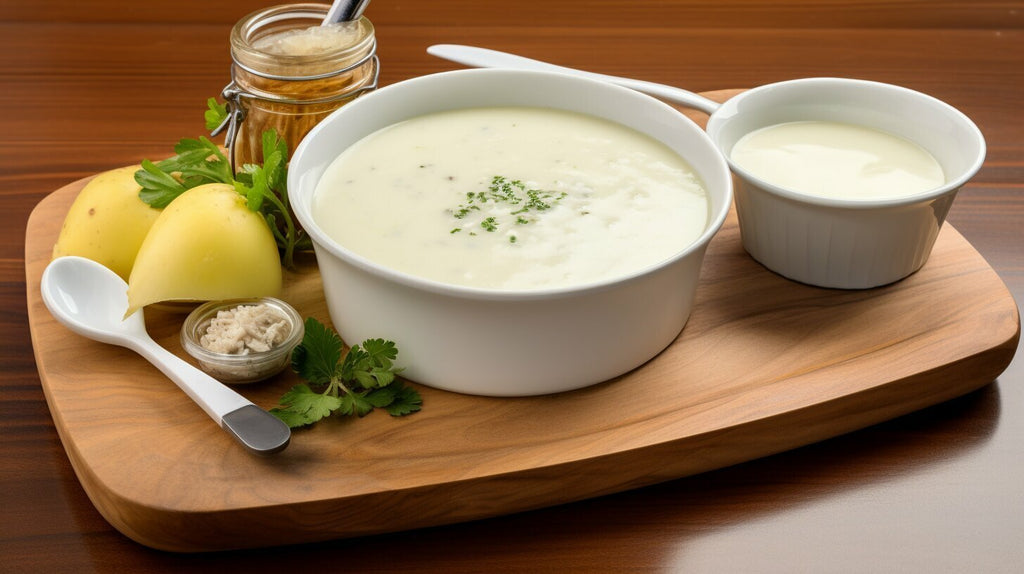
Exploring Flavor Innovations
Hydrocolloids not only contribute to the texture and consistency of New England clam chowder but also play a crucial role in enhancing its flavor profile. By manipulating the properties of hydrocolloids, chefs can experiment with different flavors without losing the traditional essence of the dish.
For instance, carrageenan, a common hydrocolloid used in clam chowder, can add a subtle sweetness and enhance the umami taste of the clams. Xanthan gum, on the other hand, can intensify the savory notes and create a more robust flavor profile. By blending different hydrocolloids, chefs can achieve a customized flavor profile that appeals to different preferences.
Hydrocolloids can also be used as carriers or encapsulating agents for flavor enhancers, such as spices, herbs, or even alcohol. By incorporating these flavor compounds into the hydrocolloid matrix, chefs can achieve a gradual release of flavors, prolonging the taste experience and creating a more sophisticated dish.

Furthermore, hydrocolloids can also mask unwanted flavors or off-notes, such as the fishy taste of the clams, while preserving their natural taste and aroma. This property is particularly useful for chefs who want to cater to a wider audience with different taste preferences.
By unlocking the flavor potential of hydrocolloids, chefs can take New England clam chowder to a new level of culinary excellence, satisfying the taste buds of both traditionalists and adventurers.
Conclusion
In conclusion, hydrocolloids have proven to be a game-changer in the culinary world, especially when it comes to perfecting regional delights like New England clam chowder. By acting as thickeners, emulsifiers, and stabilizers, hydrocolloids can transform the texture and mouthfeel of this iconic soup, achieving a smooth and creamy consistency while retaining its traditional flavor profile. Through this article, I have explored the various hydrocolloids used in clam chowder, such as carrageenan, xanthan gum, or agar, and how they contribute to achieving creaminess, flawless integration, stability, and innovative flavor experimentation. These properties of hydrocolloids offer endless possibilities for chefs and food manufacturers to elevate the taste and quality of regional delicacies. In the future, I look forward to seeing more hydrocolloid innovations in the culinary industry and the creative ways in which they will be applied to enhance traditional recipes while still keeping their essence intact. As a food lover and journalist, I am excited to see how hydrocolloids will continue to transform the way we experience and enjoy our favorite dishes.FAQ
Q: What are hydrocolloids?
A: Hydrocolloids are a class of food additives commonly used in the culinary industry. They act as thickeners, emulsifiers, and stabilizers, contributing to the texture and consistency of various food products.
Q: How do hydrocolloids enhance New England clam chowder?
A: Hydrocolloids, such as carrageenan, xanthan gum, or agar, are used in clam chowder to improve its texture and mouthfeel. They create a smooth and creamy consistency without altering the taste profile.
Q: Do hydrocolloids affect the taste of clam chowder?
A: Hydrocolloids do not alter the taste of clam chowder. They are primarily used to enhance texture, stability, and flavor integration while maintaining the traditional essence of the dish.
Q: Can hydrocolloid-thickened clam chowder be reheated?
A: Yes, hydrocolloid-thickened clam chowder can be reheated without compromising its texture or consistency. Hydrocolloids help maintain stability even under different storage and reheating conditions.
Q: Are there any alternative hydrocolloids that can be used in clam chowder?
A: While carrageenan, xanthan gum, and agar are commonly used in clam chowder, there are other hydrocolloids available. The choice of hydrocolloid may depend on specific preferences or culinary experiments, but they all serve to improve the soup's overall quality.
Q: Are hydrocolloids suitable for other dishes besides clam chowder?
A: Absolutely! Hydrocolloids are versatile ingredients that can enhance the texture, stability, and flavor of various dishes. They can be used in soups, sauces, desserts, and other culinary creations to elevate the overall dining experience.


|
About the Author Ed is the founder of Cape Crystal Brands, editor of the Beginner’s Guide to Hydrocolloids, and a passionate advocate for making food science accessible to all. Discover premium ingredients, expert resources, and free formulation tools at capecrystalbrands.com/tools. — Ed |
- Choosing a selection results in a full page refresh.




2 comments
Chef Edmund
Dear Marion,
Thank you for your comment on wound care hydrocolloids. I certainly admire your work and what you do for others.
Yes, hydrocolloids are not confined just to medicine, they are an important component among many industries.
That is due to their ability to modify the viscosity and texture of products, stabilize emulsions, and form gels. They absorb water, and their applications are vast and varied. Here are some key industries where hydrocolloids are particularly important:
Food and Beverage Industry
• Texturizing and Gelling Agents: Hydrocolloids are used to enhance texture, viscosity, and mouthfeel in products like jams, jellies, dairy products, sauces, and soups.
• Stabilizers: They help stabilize emulsions and foams in products like ice cream, whipped cream, and salad dressings, preventing separation and crystallization.
• Thickening Agents: Used to thicken products like gravies, sauces, and pie fillings.
• Dietary Fiber Source: Some hydrocolloids, such as pectin, are used to increase the fiber content of foods, contributing to health benefits.
Pharmaceutical and Cosmetics Industries
• Drug Delivery Systems: In pharmaceuticals, hydrocolloids are used to control the release of drugs in the body, improving the efficacy and safety of medication.
• Excipients: They serve as binders, disintegrants, and fillers in tablet manufacturing, contributing to the tablet’s structure and release properties.
• Skin Care Products: In cosmetics, hydrocolloids are used for their moisturizing properties and to improve the texture and application of skin care and makeup products.
Agriculture and Horticulture
• Soil Conditioners: Some hydrocolloids are used to improve soil water retention and structure, benefiting plant growth and water use efficiency.
• Seed Coatings: Hydrocolloids can be used to coat seeds, improving moisture retention and germination rates.
Paper and Textile Industries
• Paper Manufacturing: Hydrocolloids are used as additives in papermaking to improve paper quality, including its strength, printability, and resistance to grease.
• Textile Printing: They are used in textile printing as thickeners for the printing paste, allowing for precise application of dyes and patterns.
Oil and Gas Industry
• Drilling Fluids: Hydrocolloids are used in drilling muds to control viscosity, lubricate the drill bit, and stabilize the wellbore.
Water Treatment
• Flocculants: In water treatment processes, certain hydrocolloids can act as flocculants, helping to aggregate and remove suspended particles from water.
The importance of hydrocolloids across these industries lies in their ability to improve the quality, stability, and functionality of products, as well as to contribute to innovative solutions in manufacturing and environmental management. Their natural origin and biodegradability also make them an attractive option in the context of increasing demand for sustainable and eco-friendly products.
If you are interested in my favorite subject …food. Here is another article I prepared: Hydrocolloids in Cooking and Baking: Recipes and Techniques Using Spec – Cape Crystal Brands
Thanks so much for your comment.
Best regards,
Chef Edmund
Marion Clarke
As a Wound Care Certified Nurse, “hydrocolloid” has a completely different meaning and use in my world! I read the title 3 times before I understood that there was a food use for what I use on wounds! I very much enjoyed that this was a scholarly article and will seek out sources for this new-to-me cooking ingredient.